AMD Radeon HD 7750 & Radeon HD 7770 GHz Edition Review: Evading The Price/Performance Curve
by Ryan Smith & Ganesh T S on February 15, 2012 12:01 AM EST- Posted in
- GPUs
- AMD
- HTPC
- GCN
- Radeon HD 7000
Power, Temperature, & Noise
As always, we wrap up our look at a new video card with a look at the physical performance attributes: power consumption, temperatures, and noise.
While it’s the second sub-series of the 7000 series, the 7700 series is actually first in a number of ways for AMD. It’s the first midrange series to feature PowerTune since its introduction in 2010, and it’s the first time the 28nm process has been used on such low power cards. As such the power, temperature, and noise characteristics of the 7700 series are virtually a blank slate waiting to be filled.
| Radeon HD 7700 Series Voltages | ||||
| Ref 7750 Load | Ref 7770 Load | XFX R7770 BESDD | ||
| 1.1v | 1.2v | 1.2v | ||
The idle voltage for all 3 of our 7700 series cards was 0.825v. Meanwhile the load voltage for our 7750 was 1.1v, while it was 1.2v for both the reference 7770 and the XFX BESDD.
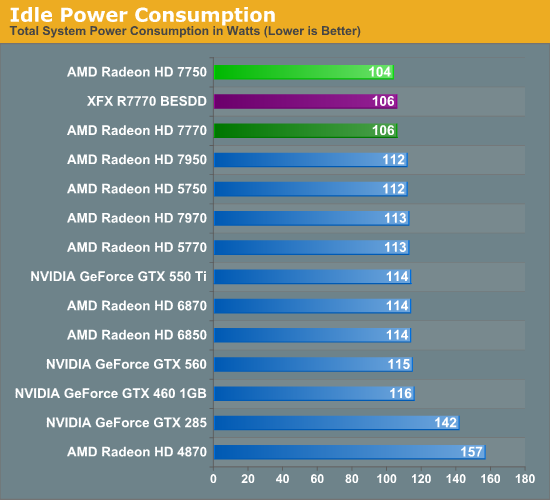
AMD’s official idle power consumption figure is <10W for both the 7750 and 7750. In practice we find that there’s a 2W difference between the two cards, with the 7750 coming in at 104W at the wall and the 7770 at 106W. AMD’s continuing efforts to reduce idle power consumption are clearly paying off, making this the lowest idle power usage figures we’ve recorded yet.
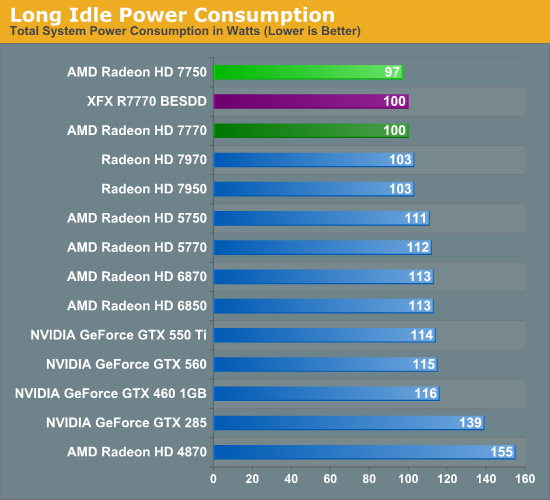
Meanwhile under the so-called “long idle” scenario with a blank monitor, the 7000 series continues to cement its lead. Officially all Southern Islands cards have a long idle power consumption level of <3W since they should all be using the same PCIe controller to keep a heartbeat going, however we’re finding there is a difference, even between the 7750 and 7770. The 7770 consumes 3W less than the 7900 series, meanwhile the 7750W consumes another 3W less, bringing it down to 97W. Since our readings are from the wall it’s tough to gage just how much these cards are still using, but at this point there doesn’t seem to be much farther to drop.
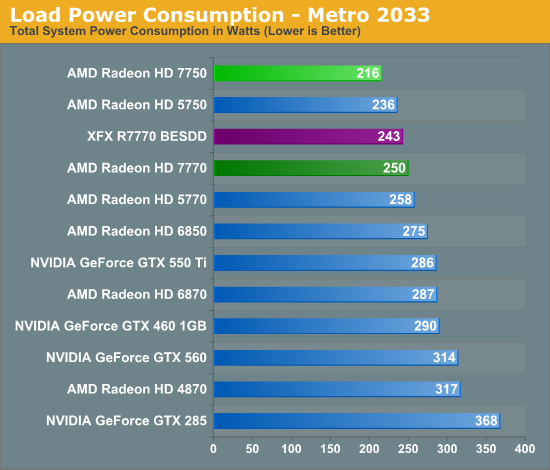
When we talk about the 7700 series bluring the line between what we’d expect out of an AMD 700 series card and an AMD 600 series card, results like this are part of the reason why. With a 75W PowerTune limit the 7750 has the lowest power consumption of any of the cards in our lineup, beating even the 5750. The 7750 is clearly in a league of its own, with only the 7770 drawing similar amounts of power as the 5700 series.
To that extent, it’s interesting to note that the XFX BESDD consumes less power than the reference 7770, in spite of its factory overclock. XFX did not increase the voltage of the card, but we’d still expect power consumption to go up at least a bit, not come down. In any case even with its 10% better performance, it’s consuming 7W less than the reference 7770 here. Otherwise at 250W the 7770 is pulling 8W less than the 5770 and 25W less than the 6850 from the wall, succinctly showcasing the power benefits of TSMC’s 28nm process.
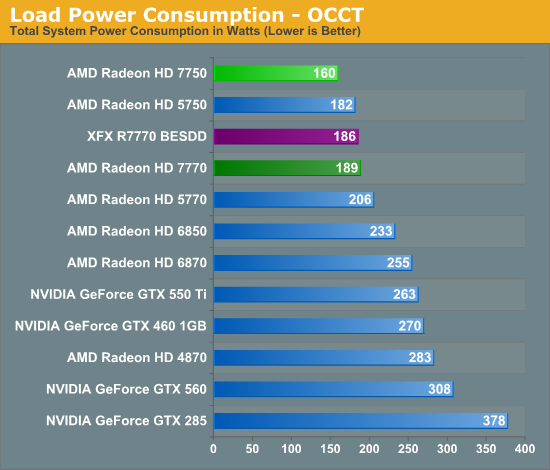
Our results with OCCT largely mirror Metro, with the 7750 in a class of its own while the 7770 consumes less power than anything other than the 5750. Since this is our pathological test, the lack of PowerTune plays a big part here, as PowerTune keeps the 7770 capped at 100W while the 5770 and 6850 are free to go well over their TDPs.
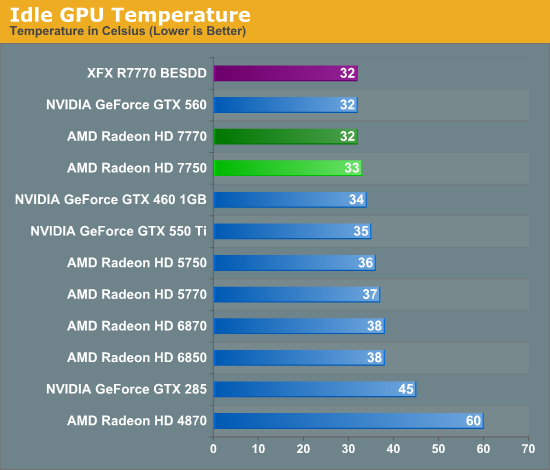
There’s little to say about idle temperatures that hasn’t been said before. With a half-decent cooler, almost any card can reach the mid-to-low 30s. The 7700 series is no exception.
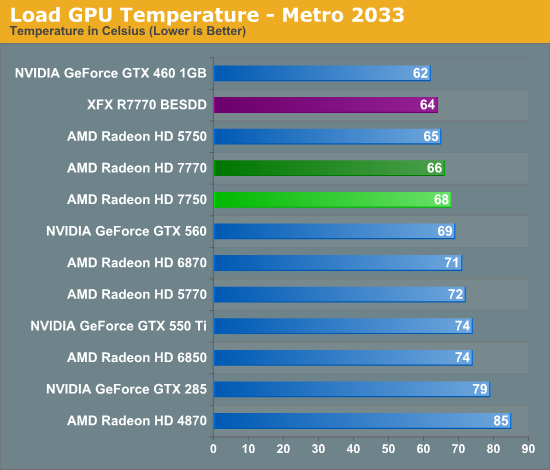
Moving on to Metro, our results are largely consistent with what we’d expect given our earlier power data. Even with the lower power consumption of the 7700 series AMD can’t quite beat the GTX 460 1GB, otherwise with temperatures in the mid to upper 60s the 7700 series looks quite good. XFX’s BESDD looks especially good thanks to the fact that it’s an open air cooler, as it only reaches 64C.

As with OCCT power consumption, OCCT temperatures are largely a story of PowerTune or the lack thereof. With PowerTune clamping down on power consumption, temperatures never rise by too much. At 71C the reference 7770 is still doing well, while XFX’s card does even better.
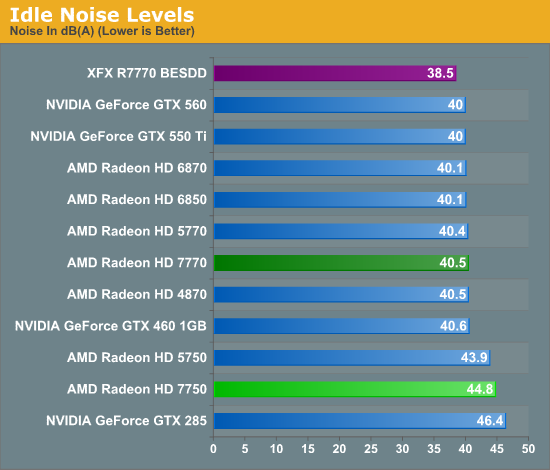
Based on our power and temperature data, our noise data came at somewhat of a disappointment. The 7750 has a small fan with an idle fanspeed of 39%, leading to it being quite loud relative to its competitors. Thankfully none of AMD’s partners will be using that specific cooler, so we wouldn’t expect any retail cards to be this bad. Though if silence is key, Sapphire’s passively cooled 7750 is always an option.
As for our 7770 cards there aren’t any surprises. The open air cooled XFX BESDD does the best, though at only 40.5dB the reference 7770 is doing almost as well on its own.
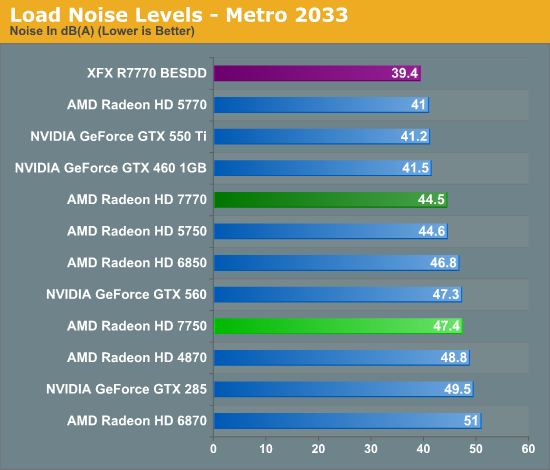
I had to rerun Metro a few times just to make sure our XFX BESDD numbers are right; and they were. XFX’s open air cooler combined with the 100W board limit of the 7770 means that there’s relatively little heat to dissipate, which the open air cooler does extremely well. While this isn’t technically silent it’s damn close.
Elsewhere the reference 7770 does decently, but its half blower nature hurts it when it comes to noise. The noisy 7750 only gets louder, unfortunately.
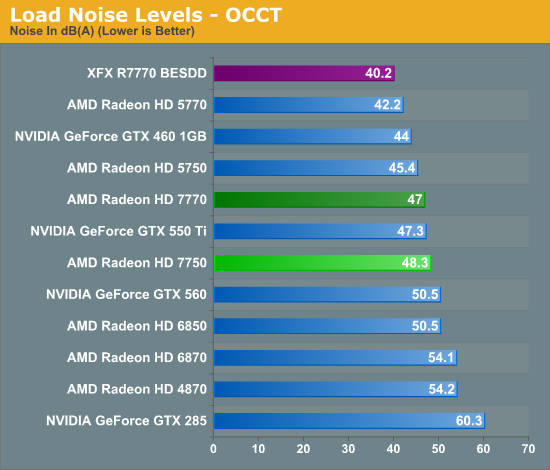
Finally, noise under OCCT is nearly the same story. The XFX BESDD finally goes above 40dB, a testament to the capabilities of XFX’s open air cooler. As for the AMD cards, there’s really not a great deal positive to say as even a traditional blower shouldn’t be quite as bad as what we’re seeing with the reference 7770. Perhaps it’s for the best that none of AMD’s partners are using their reference designs.










155 Comments
View All Comments
bazinga77 - Wednesday, February 15, 2012 - link
here is the thing to be honest. if you complain about the price that seems like a fair complaint. however one has to wonder how much it costs amd and nvidia in losses to keep dropping prices to stay competitive. at some point it has to catch up with you. with the losses amd has suffered with bulldozer they have to be smarter with the prices. also until nvidia launches something new they can stay a little heavy handed with the prices unless nvidia forces the issue especially as we see some of the older cards go away and amd has said that the 6xxx series cards are no longer in production and haven't been for months. so right now the pricing seems a little bit off but what about once you can't get a 6850,6870, of gtx 460 ti? it will make more sense then.finally if you expected a 77xx series card to blow anything out of the water with its limited memory bandwidth of 128 bit memory then frankly you are either not very intelligent or naive. this is a lower mid ranged card that almost beats last gens upper mid range card. that is not bad. this card was never going to blow the roof off and if you thought it could will that just wasn't the best thought process you ever had.
Markstar - Wednesday, February 15, 2012 - link
I'm sorry, but you entirely missing the point of the whole concept of the IT industry. Graphic cards are not groceries, where you are lucky if you can still buy them for the same price 18 months later. The desktop market is declining, so there are plenty of computers out there fast enough to run Firefox and Word.There HAS to be an incentive to buy new parts - and especially now that integrated graphics are fast enough for 1080p and casual games, this HAS to involve a performance gain in some form or another to get people to buy a dedicated graphic card, let alone upgrade from their existing one.
Who is going to buy this card? Seriously, who? A person who is tight on money should look on Ebay, where you get a used 5770/6770 for $60. Everyone else is bettor off buying the 6850 or going to NVidia.
Frankly, you are a bit naive if you think we will applaud AMD for releasing such an underachiever. As it stand now, AMD would have been better off with another round of rebadging (thereby saving money on R&D and freeing up 28nm wavers).
Sad, very sad. :(
bazinga77 - Wednesday, February 15, 2012 - link
integrated graphics aren't good enough to run most games. if by casual games you mean angry birds then i guess i would agree with that.most gpu's come out higher in price initially then we expect or want especially when newer cards come out while the other vendor, in this case nvidia, is a ways away from releasing there next gen cards. sure we can bash this card but to do so we have to assume nvidia is going to blow amd out of the water. sure amd has been rebranding their cards the last two cycles but nvidia is more guilty of that then anyone. so as the current market stands the price is a little high. but lets be honest it is only looking that way because cards like the 6850 are still available, which won't be the case in the very near future.
i guess if you want to buy a used gpu off of ebay with no warranty then someone can do that and if it craps out in a month then they can deal with that as well. and if someone is tight on money and only going to spend $60 then i doubt they are on a site like this and care about benchmarks let alone at 1080p etc.
the gtx 460 is becoming harder and harder to find and the gtx 560 is over $200 so i don't see a huge issue. i expect the cards to lower in price next month when the 7850 launches and the 7770 will settle down into a more comfortable range. if you buy a gpu or cpu day one you will always pay more typically then a couple of months later.
i don't think amd should be applauded but i think people need to be realistic. when nvidia released the 550 ti it didn't even get close to the gtx 460 ti, yet that is the exact thing amd is getting bashed for. the 550 ti competes with the 6770 and 6790, while the 6850 was trying to get closer to competing with the gtx 560 and gtx 460. like i said the 550 ti didn't perform better than the gtx 460, not even close, yet you expect amd to release a card that would typically compete against a card like the 550 ti (in its respected generation, being the next nvidia card that would replace the 550 ti) and you expect it to compete at a higher class than it is released. sure the price isn't perfect but you are expecting a civic released to compete with a corolla to actually compete with bmw 1 series.
bhima - Wednesday, February 15, 2012 - link
Uhh... its really not hard to find a GTX560 for under $200.$170 : http://www.newegg.com/Product/Product.aspx?Item=N8...
$175: http://www.newegg.com/Product/Product.aspx?Item=N8...
$185: http://www.newegg.com/Product/Product.aspx?Item=N8...
We expect the card to compete with this because its priced a bit higher than this old tech:
HIS ICEQ 6870 $170: http://www.newegg.com/Product/Product.aspx?Item=N8...
chizow - Wednesday, February 15, 2012 - link
Great points Markstar, I'm glad there's others who understand the issus with the 7-series pricing many people have.TerdFerguson - Wednesday, February 15, 2012 - link
Thanks for the honest review. AMD deserves to be dragged through the coals for trying to sell us something that costs more and performs worse than a two-year-old card. This constitutes an epic failure in the world of consumer electronics. The more you stress it, the more it feels like you're an advocate of the consumer and not the greedy corporate suits.Bull Dog - Wednesday, February 15, 2012 - link
On VCE and the Test page, "7700 series launch is a bit more unsettling. These are cards that are going to be paired with slower GPUs, where having a high speed H.264 encoder is going to be all the more important."I believe it should be CPU and not GPU there.
pandemonium - Wednesday, February 15, 2012 - link
I think it's pretty obvious that AMD is milking what they can while the buzz of the architecture and die size is fresh - primary opponent being absent in their next series release and all. In a month it'll be a different story. Prices will have settled in to where they belong after all the manufacturer's have their versions readily available. I don't really see how this is a big deal. Has any card released been placed appropriately immediately at debut?kevith - Wednesday, February 15, 2012 - link
I am the lucky owner of a XFX HD4770.It´s fairly ok for my use, music production and occasional gaming.
I would like something a bit newer though, that can handle new games in full HD.
And now I have witnessed the launch of 5750/70, 6750/70 and now 7750/70. The 5770 being "the peoples champ" for quite a while, as my 4770 could and would have been in its time, if it wasn´t for availability problems. (Probably created by AMD on purpose, realizing, that the card was to cheap.)
But as far as I can read everywhere, the 6770 is simply another 5770. And the 5770 wouldn´t really give me a significant improvement over my 4770. Never mind DX11 and Eyefinity and all that jazz.
SO. Where should I go for a difference I can feel and see right away? 6870? Prices doesn´t give ANY clue anymore, as Anandtech pointed out with this - and previous articles.
I look at Tom´s "Best card for the money..." round-ups, but I don´t get much wiser.
It sure is a jungle out there...
silverblue - Wednesday, February 15, 2012 - link
The 4770 was far too similar in performance to the 4830 it was replacing. The 4770 was more of a test for 40nm manufacturing than anything else.The 6850 and 6870 are definitely worthy of the cash.